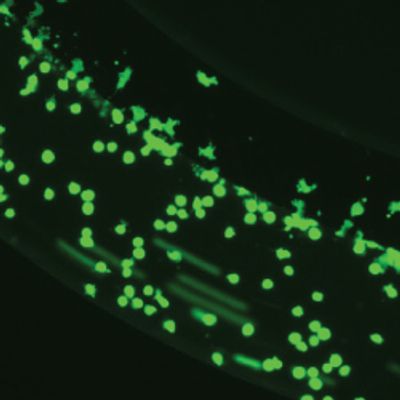
- Home
- Companies
- SynVivo, Inc.
- Products
- SynRAM - 3D Inflammation Model

SynRAM - 3D Inflammation Model
The SynRAM™ 3D Inflammation Model from SynVivo was developed to study the entire inflammation pathway in a dynamic environment. The SynVivo platform delivers a physiologically realistic model (including flow and shear) and enables real-time tracking of rolling, adhesion, and migration processes. The model recreates a histological slice of co-cultured tissue and/or tumor cells with a lumen of endothelial cells. It has been successfully validated against in vivo studies showing excellent correlation with rolling velocities, adhesion patterns, and migratory processes (Lamberti et al 2014, Soroush et al 2016).
The SynRAM 3D inflammation model provides a realistic testing environment including:
- Physiological shear stress within a microvascular environment
- In vivo like vascular morphology with fully enclosed lumen
- Co-culture capability for cell-cell interactions
- Quantitative real-time rolling, adhesion, and migration data from a single experiment
SynRAM enables assessment of cellular interactions comprising of rolling, adhesion, and migration through multiple cellular layers in one experiment, in real-time, and represents data closely correlated with in vivo results.
SynRAM’s innovative design overcomes the current limitations inherent in flow chambers or Transwell chamber based assays. Current flow chamber designs are oversimplified, lack the scale and geometry of the microenvironment, and cannot model transmigration. Similarly, Transwell chambers do not account for fluid shear and size/topology observed in vivo. In addition, endpoint measurements of migration are not reproducible in a Transwell chamber and do not provide real-time visualization.
SynVivo’s proprietary chip designs range from complex in vivo derived microvascular networks (obtained from digitized images) to simplified idealized networks. Complex in vivo networks produce realistic cellular makeup and vascular morphology resulting in varying shear and flow conditions. Simplified idealized networks are designed to reproduce cellular makeup, constant shear, and flow conditions.
Chips: Depending on your specific research applications you can select from IMN2 radial SMN2 microvascular network chip configurations.
Kits: All the basic components required to run SynRAM assays can be purchased in a kit format. Two Kit formats are available.
Starter Kit: Select this for your first-time purchase
- 10 SynRAM chips (Choice of IMN2 radial or SMN2 microvascular network chips)
- Accessories including tubing, clamps, needles, and syringes
- Pneumatic priming device (required for priming tubing to remove air)
Assay Kit: Select this kit format if you have previously purchased the pneumatic priming device
- 10 SynRAM chips (Choice of IMN2 radial or SMN2 microvascular network chips)
- Accessories including tubing, clamps, needles, and syringes
Schematics of the devices used to develop SynRAM inflammation models. Apical chamber (outer channels) are for culture of vascular (endothelial cells) while basolateral chamber (central chamber) are for culture of tissue cells. Porous architecture enables communication between the vascular and tissue cells.
